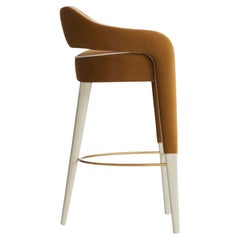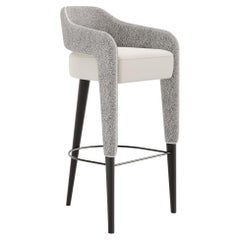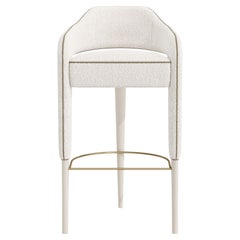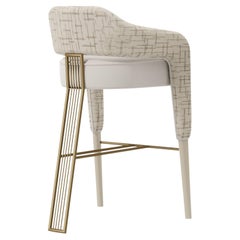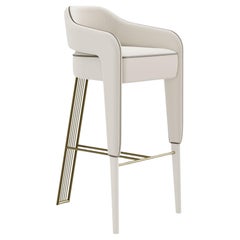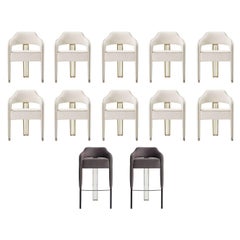Invicta Bar Stool
21st Century and Contemporary Portuguese Modern Stools
Brass
21st Century and Contemporary Portuguese Modern Stools
Brass
21st Century and Contemporary Portuguese Modern Stools
Brass
21st Century and Contemporary Portuguese Modern Stools
Brass, Stainless Steel
21st Century and Contemporary Portuguese Modern Stools
Brass, Stainless Steel
Recent Sales
21st Century and Contemporary Portuguese Modern Dining Room Chairs
Brass
People Also Browsed
Vintage 1970s American Hollywood Regency Stools
Brass
Vintage 1950s Indian Mid-Century Modern Club Chairs
Teak
2010s Danish Modern Chandeliers and Pendants
Aluminum, Iron
21st Century and Contemporary American Modern Coffee and Cocktail Tables
Art Glass, Cut Glass, Walnut
2010s Scandinavian Modern Chandeliers and Pendants
Brass
2010s Italian Desks and Writing Tables
Wood
2010s British Scandinavian Modern Ottomans and Poufs
Sheepskin, Oak
21st Century and Contemporary Portuguese Modern Wall Mirrors
Mirror, Lacquer
Vintage 1980s Italian Mid-Century Modern Chandeliers and Pendants
Glass
21st Century and Contemporary Portuguese Modern Sofas
Leather, Fabric, Bouclé, Wood, Mohair, Velvet, Lacquer
21st Century and Contemporary Portuguese Modern Sofas
Velvet
2010s European Mid-Century Modern Wall Lights and Sconces
Brass
2010s French Modern Wall Lights and Sconces
Alabaster, Bronze
21st Century and Contemporary Canadian Modern Benches
Leather, Wood, Oak
21st Century and Contemporary American Modern Chandeliers and Pendants
Alabaster, Metal, Gold Leaf
Vintage 1980s Italian Mid-Century Modern Flush Mount
Metal, Chrome
A Close Look at Modern Furniture
The late 19th and early 20th centuries saw sweeping social change and major scientific advances — both of which contributed to a new aesthetic: modernism. Rejecting the rigidity of Victorian artistic conventions, modernists sought a new means of expression. References to the natural world and ornate classical embellishments gave way to the sleek simplicity of the Machine Age. Architect Philip Johnson characterized the hallmarks of modernism as “machine-like simplicity, smoothness or surface [and] avoidance of ornament.”
Early practitioners of modernist design include the De Stijl (“The Style”) group, founded in the Netherlands in 1917, and the Bauhaus School, founded two years later in Germany.
Followers of both groups produced sleek, spare designs — many of which became icons of daily life in the 20th century. The modernists rejected both natural and historical references and relied primarily on industrial materials such as metal, glass, plywood, and, later, plastics. While Bauhaus principals Marcel Breuer and Ludwig Mies van der Rohe created furniture from mass-produced, chrome-plated steel, American visionaries like Charles and Ray Eames worked in materials as novel as molded plywood and fiberglass. Today, Breuer’s Wassily chair, Mies van der Rohe’s Barcelona chair — crafted with his romantic partner, designer Lilly Reich — and the Eames lounge chair are emblems of progressive design and vintage originals are prized cornerstones of collections.
It’s difficult to overstate the influence that modernism continues to wield over designers and architects — and equally difficult to overstate how revolutionary it was when it first appeared a century ago. But because modernist furniture designs are so simple, they can blend in seamlessly with just about any type of décor. Don’t overlook them.
Materials: Brass Furniture
Whether burnished or lacquered, antique, new and vintage brass furniture can elevate a room.
From traditional spaces that use brass as an accent — by way of brass dining chairs or brass pendant lights — to contemporary rooms that embrace bold brass decor, there are many ways to incorporate the golden-hued metal.
“I find mixed metals to be a very updated approach, as opposed to the old days, when it was all shiny brass of dulled-out silver tones,” says interior designer Drew McGukin. “I especially love working with brass and blackened steel for added warmth and tonality. To me, aged brass is complementary across many design styles and can trend contemporary or traditional when pushed either way.”
He proves his point in a San Francisco entryway, where a Lindsey Adelman light fixture hangs above a limited-edition table and stools by Kelly Wearstler — also an enthusiast of juxtapositions — all providing bronze accents. The walls were hand-painted by artist Caroline Lizarraga and the ombré stair runner is by DMc.
West Coast designer Catherine Kwong chose a sleek brass and lacquered-parchment credenza by Scala Luxury to fit this San Francisco apartment. “The design of this sideboard is reminiscent of work by French modernist Jean Prouvé. The brass font imbues the space with warmth and the round ‘portholes’ provide an arresting geometric element.”
Find antique, new and vintage brass tables, case pieces and other furnishings now on 1stDibs.
Finding the Right Stools for You
Stools are versatile and a necessary addition to any living room, kitchen area or elsewhere in your home. A sofa or reliable lounge chair might nab all the credit, comfort-wise, but don’t discount the roles that good antique, new and vintage stools can play.
“Stools are jewels and statements in a space, and they can also be investment pieces,” says New York City designer Amy Lau, who adds that these seats provide an excellent choice for setting an interior’s general tone.
Stools, which are among the oldest forms of wooden furnishings, may also serve as decorative pieces, even if we’re talking about a stool that is far less sculptural than the gracefully curving molded plywood shells that make up Sōri Yanagi’s provocative Butterfly stool.
Fawn Galli, a New York interior designer, uses her stools in the same way you would use a throw pillow. “I normally buy several styles and move them around the home where needed,” she says.
Stools are smaller pieces of seating as compared to armchairs or dining chairs and can add depth as well as functionality to a space that you’ve set aside for entertaining. For a splash of color, consider the Stool 60, a pioneering work of bentwood by Finnish architect and furniture maker Alvar Aalto. It’s manufactured by Artek and comes in a variety of colored seats and finishes.
Barstools that date back to the 1970s are now more ubiquitous in kitchens. Vintage barstools have seen renewed interest, be they a meld of chrome and leather or transparent plastic, such as the Lucite and stainless-steel counter stool variety from Indiana-born furniture designer Charles Hollis Jones, who is renowned for his acrylic works. A cluster of barstools — perhaps a set of four brushed-aluminum counter stools by Emeco or Tubby Tube stools by Faye Toogood — can encourage merriment in the kitchen. If you’ve got the room for family and friends to congregate and enjoy cocktails where the cooking is done, consider matching your stools with a tall table.
Whether you need counter stools, drafting stools or another kind, explore an extensive range of antique, new and vintage stools on 1stDibs.
- 1stDibs ExpertNovember 2, 2021The most comfortable bar stool is a matter of preference. There are many different types of bar stools for your house, and many different comfy versions have been developed over time. To select the best one, we suggest thinking about height, weight, design and fabric so you can find the best set for your preferences and budget. Shop a collection of antique, vintage and contemporary bar stools from some of the world’s top dealers on 1stDibs.
- 1stDibs ExpertFebruary 22, 2021The height of a bar stool is typically around 28 to 38 inches tall. This is because bar tops are usually around 40 to 42 inches high, so bar stools need to be under this height in order to provide ample leg room.
- Why is it called a bar stool?1 Answer1stDibs ExpertNovember 13, 2024Why it is called a bar stool has to do with where you typically place this type of furniture. Usually featuring seat heights of 28 to 33 inches, these chairs situate a user at a comfortable level to eat and drink at a bar, whether in a home or in a restaurant. Bar stools are taller than seating intended for use at kitchen counters, known as counter stools, which usually have a seat height of 24 to 27 inches. On 1stDibs, find a diverse assortment of counter stools.
- 1stDibs ExpertApril 5, 2022Yes, bar stools are taller than counter stools. The average height of counter stools is 24 inches, and they are best suited for counter height tables and kitchen islands. Barstools are typically an additional five to six inches taller to fit the height of traditional bar counters. Shop a wide selection of bar stools and counter-height stools on 1stDibs.
- 1stDibs ExpertApril 26, 2024The difference between bar stools and counter stools comes down to height. Bar stools are usually between 28 and 32 inches tall to provide comfortable seating at bars and bar-height tables. To pair with kitchen counters and counter-height tables, counter stools are normally 24 to 27 inches tall. Find a large collection of dining stools on 1stDibs.
- 1stDibs ExpertFebruary 21, 2023Whether saddle bar stools are comfortable is largely a matter of personal opinion. However, some people find the curved seats featured on these stools supportive because they conform to the body's contours. Find a variety of saddle bar stools on 1stDibs.
- 1stDibs ExpertApril 5, 2022A standard bar stool will sit around 29 to 32 inches high, and extra-tall bar stools will sit around 33 to 36 inches high. To ensure the best fit for your space, measure the height of the bar or table you want to accent. Shop a wide selection of bar stools on 1stDibs.
- 1stDibs ExpertApril 5, 2022The comfort of a rattan bar stool is really a matter of preference. Some styles are crafted with a back or cushion for additional comfort, while some may support the addition of a cushioned seat. On 1stDivs, find a range of rattan bar stool styles to suit any preference.
- 1stDibs ExpertSeptember 25, 2019
Since counters are generally 34 to 39 inches high, counter stools should be 24 to 27 inches tall; bars are 40 to 46 inches from the ground, so bar stools typically stand 30 to 36 inches tall.
- 1stDibs ExpertApril 5, 2022Counter height bar stools are stools that typically have a seat around 24 inches to 27 inches high and are designed to provide seating along a bar or at counter height tables. On 1stDibs, find an array of counter height bar stools from top sellers.
- 1stDibs ExpertFebruary 13, 2023The best wood for bar stools is largely a matter of personal preference. Walnut, oak, cherry and birch are commonly used materials. On 1stDibs, find a selection of bar stools from some of the world's top sellers.
- 1stDibs ExpertMarch 22, 2022To identify Marcel Breuer bar stools, start by examining the frame. Genuine models will usually feature smooth, welded ends. Most reproductions have end caps instead. You can also look for a sticker that bears the model name on the underside of the seat. On 1stDibs, find a range of expertly vetted Marcel Breuer bar stools.
Read More
The 21 Most Popular Mid-Century Modern Chairs
You know the designs, now get the stories about how they came to be.
Eileen Gray’s Famed Cliffside Villa in the South of France Is Returned to Its Modernist Glory
After years of diligent restoration, E-1027, the designer-cum-architect’s marriage of romance and modernism, is finally complete.
See How New York City Designers Experiment on Their Own Homes
There are many lessons to be learned from the lofts, apartments and townhouses of architects and decorators in Manhattan and beyond.
Jeff Andrews Captures Old Hollywood Glamour in His Cinematic Spaces
Having created extravagant homes for reality TV’s biggest stars, the designer is stepping into the spotlight with his first book.
New Orleans’ Lee Ledbetter Makes Design Magic by Mixing Past and Present
The Louisiana-born and -bred architect talks to 1stdibs about the art of making timeless places that matter.
How a Modernist Hamptons Home on the Water Became the Ideal Weekend Refuge
Damon Liss and Stelle Lomont Rouhani Architects collaborated on this serene getaway for a minimalism-minded Manhattan family of four.
Desert Modern Designer Arthur Elrod Finally Gets His Day in the Sun
The Palm Springs interior decorator developed a mid-century style that defined the vacation homes of celebrities and other notables, including Bob Hope and Lucille Ball.
Artelinea, Mexico City’s One-Stop Contemporary Design Shop, Paves the Way for a New Wave of Mexican Designers
Wielding her influence on the international scene, founding partner Andrea Cesarman expands the platform for Mexican artisans.
